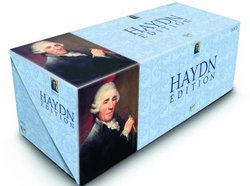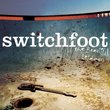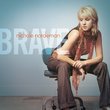| All Artists: Haydn Title: Haydn Edition Members Wishing: 0 Total Copies: 0 Label: Brilliant Classics Original Release Date: 1/1/2008 Re-Release Date: 11/11/2008 Album Type: Box set Genre: Classical Style: Symphonies Number of Discs: 150 SwapaCD Credits: 150 UPCs: 842977037821, 5028421937823 |
Search - Haydn :: Haydn Edition
CD DetailsSimilarly Requested CDs
|
CD ReviewsBrilliant Classics releases another splendid box set Mike Birman | Brooklyn, New York USA | 11/17/2008 (5 out of 5 stars) "Brilliant Classics has made a specialty of releasing exhaustive box set overviews of the music of canonic composers such as Bach and Mozart at bargain prices. Containing 150 or more cds, their music has either been specially recorded for Brilliant or licensed older recordings. Although the quality of the individual recordings has generally been variable, the musical value of the previous sets has been surprisingly high. The Bach set was distinguished by all of the great Baroque master's approximately 200 known cantatas in good versions that provide an economical alternative to John Eliot Gardiner's superb ongoing series. The Brilliant recordings have a down-to-earth grittiness that suggest how these cantatas must have sounded as they were unveiled to Bach's congregation on a weekly basis. Not a day goes by without my listening to at least one of them. This new Haydn box set, released in celebration of the bicentennial of Haydn's death at age 77 in 1809. is vast yet not complete. It too has a distinguished series that essentially pays for itself: the complete 104 symphonies in superb recordings by Adam Fischer leading the Austro-Hungarian Haydn Orchestra originally made for the now defunct Nimbus records. Wonderfully performed and featuring deep reverberant acoustics, listening to Haydn's unending inspiration over 35 years in a genre he essentially created is to witness the unfolding history of instrumental music in the second half of the 18th century. The set also contains some of Haydn's finest operas, composed for his patron Prince Esterhazy. La Fedeltà Premiata, HOB.28 no.10 composed in 1780 and L'infedeltà Delusa, HOB.28 no.5 written in 1773 are probably the two best known operas included here. Although Haydn never possessed Mozart's innate dramatic genius, his music is often lovely and a joy to listen to in performances that are never less than good. Here, too, are the late oratorios: The Creation and The Seasons in good performances featuring Helen Donath (Soprano), Adalbert Kraus (Tenor), and Kurt Widmer (Bass). Also included in this set are Haydn's magnificent series of late masses performed by the Württemberg Chamber Orchestra Heilbronn. These are fair to good performances: eclipsed somewhat when I compared them to John Eliot Gardiner's recent DGG recordings (which are superb), but they still managed to favorably withstand comparison to other versions that I've heard. All of the Baryton Trios are featured in very strong period performances. These are some of Haydn's most compelling compositions and they remain surprisingly unheralded to this day. Almost all of the attributed string quartets are here in solid recordings made especially for Brilliant by the Buchberger Quartet. There are also historically informed interpretations of the complete piano sonatas on instruments of Haydn's day. Haydn's instrumental concertos are here in licensed recordings of variable quality: some good, some slightly less so (though never bad). Many of Haydn's Lieder and Folksongs are included in this set, rarities one would be hard-pressed to find anywhere in performances this entertaining. The list goes on. If Haydn's music is as much of a joy to you as it is to me - uplifting, earthy, full of life and good rollicking humor - this 150 cd box set is an economical treasure chest that will never cease to reap rewards over a lifetime of listening. Dip into it and you are bound to find something that will delight and surprise you. Most strongly recommended. Mike Birman" On a par with Brilliant Classic's Bach and Mozart sets Michael Schell | www.schellsburg.com | 12/28/2008 (5 out of 5 stars) "Brilliant Classics has brought forth another winner with this set. Its lynchpin is the Adam Fischer survey of the 106 symphonies (plus the Sinfonia Concertante), which was originally recorded for Nimbus over 14 years, then rereleased by Brilliant Classics as a 33-disk set a few years ago then rereleased by Brilliant Classics a few years ago. Alas, the program notes booklet included with the earlier Brilliant Classics set is not included here. Fischer's interpretations are historically informed, but use modern instruments, to generally good effect, though not as stunningly so as a period instrument specialist might. Still, it's a vast improvement over hearing these symphonies performed in a typical rendering by a modern orchestra using 19th/20th Century instruments, playing techniques, and ensemble sizes. Check out the reviews both here and on the Web of Fischer's set. The general consensus is that they're strong on the early symphonies and somewhat lackluster with the later, well-known symphonies (which were actually the first to be recorded, with No. 88 getting re-recorded by the ensemble at the end of the recording process, many years after it began). One of the high points of this collection is the survey of Haydn's piano sonatas, performed on copies of period instruments by Bart van Oort, Ursula Dütschler, Stanley Hoogland and Yoshiko Kojima. The musicians acquit themselves quite well, though the occasional engineering error creeps in (in the Finale of Piano Sonata No. 38, you'll hear an editing error -- an extraneous note -- in the left channel at 1:52). The chromaticism and expressive depth of some of these sonatas is stunning, often in excess of that displayed by Haydn's orchestral music. As I listen through these sonatas, most of which are unfamiliar to me, I wonder why even the best of them are so seldom played nowadays. Perhaps the choice of instrument is crucial. Contrast the sound of Sonata. 46 (in A-flat major), with the repeated notes in the first movement, to that of a modern piano, and you'll see why listening to this music on a fortepiano can be so thrilling. Many of these pieces don't translate so well to the modern instrument, with its steel frame, triple treble strings, thousands of pounds of tension, a long resonant decay, etc. that make it so well suited to Brahms, Liszt, Copland, Stockhausen, etc. Dig the trio to Sonata No. 12 (on CD 137), where Oort slows the tempo and relates Haydn's two-voice writing to what followed decades later at the hands of Chopin and Schumann. Later on that CD, hear a big exhalation from Mr. Oort a few seconds after the finale of Sonata No. 50. If you can track it down, and can read music, follow along with Tovey's analysis of the last sonata, No. 52 in E-flat major (which Tovey labeled as No. 1 based on the numbering available to him). The piano trios are also given loving treatment, including a period keyboard instrument and historically-informed playing techniques. Charles Rosen devotes a chapter in his book "The Classical Style" to these underappreciated works. They've become a mainstay on my nightstand CD player. Second in importance only to the symphonies, Haydn's string quartets are handled here by the Buchberger Quartet. I'm not very familiar with this ensemble, and there are no program notes provided regarding their playing techniques (sadly, the notes accompanying the individual CDs in Brilliant Classics' Haydn string quartet series were omitted from Haydn Edition). Their interpretations sound somewhat historically informed to me, but not completely so. For example, the ensemble takes Prestos faster than you might expect, minuets slower than you might expect, and generally avoids the habitual vibrato used by conventional string players. But they play at A=440, rather than, say, 430 (which would apparently be closer to the standard in Haydn's time), and the violins seem to have metal A and E strings. I can't tell if they're using modern bows or the the transitional bows from Haydn's time that were concave like modern bows (and unlike the earlier convex Baroque bows), but had less hair and more bounce than today's bows). I understand that Hubert Buchberger plays a 1775 Storioni, though I don't know if it has been modernized with newer fittings like most Cremona violins played today. I'll stand corrected if I can find better documentation on the players' instruments. Another interesting point is that the musicians are apparently using earlier editions of the string quartets where available (rather than the 1800-01 published revisions that most other ensembles use). The Buchberger Quartet certainly gives a listenable rendering of these quartets, barring some shaky intonation in the first violin's top register (Haydn wrote especially prominent first violin parts in the early quartets, presumably with Luigi Tomasini in mind, and it must also be conceded that it's harder to play in tune when you're not employing the habitual vibrato used in modern string technique). The enthusiasm of the performers comes through clearly, and though they might not be as revelatory as you'd get with an outfit like L'Archibudelli, they've been an unabashed source of ear candy for me by way of headphones, the car stereo, and the nightstand CD player. The 100+ baryton trios were recorded specifically for Brilliant Classics right in Esterházy. The musicians do a fine job on this obscure repertory, and it's great to hear the sound of this pretty but inflexible instrument in their original acoustical settings. Let's be clear though, most of this music is not vintage Haydn. Given the limitations of both the baryton and the Prince who played it (Haydn's notes don't go by very fast, and the music seems perpetually stuck in A major and a couple related keys), it's not surprising that the pieces often sound like hack work. I can hardly blame Haydn for not putting his most inspired ideas into these parochial pieces that didn't seem destined to travel very far from Eisenstadt. One thing that strikes me about the baryton is that its viola da gamba-like attack envelope (a very slow rise time, since it's played with an underhand bow with little tension) seems to make it particularly unsuited to Classical period music, which thanks to Haydn and his contemporaries was starting to explore a greater range of rhythm and dynamics, at the expense of textural complexity, than its Baroque antecedents. This instrument would work decently well as a polyphonic voice performing, say, Buxtehude, but it's inability to keep up with the contrasts in dynamics and bowing that the accompanying viola and cello are capable of becomes quite evident in these trio. The baryton often seems to plod along, like an old grandparent being helped across the street by a couple teenagers. The lira organizzata concertos are a reissue of a Vox recording that also appeared as part of a Concerto Royale three-CD set. The recordings are not dated by Brilliant Classics, and are marked ADD. They feature Hugo Ruf playing what sounds like an adapted harmonium. More recent reconstructions of the lira organizzata seem to give more emphasize to its hurdy-gurdy origins (historically this short-lived contraption was apparently a combination of the two instrument types), and to my ears produce a more unique and compelling sound. So the sound on these tracks is a bit of a disappointment for me. (A true hurdy-gurdy, with strings contacted by a perpendicular rotating wood disk with lots of resin applied, produces an unmistakable sound.) You might try to track down the currently out-of-print Koch recording, or the recording by Ensemble Baroque de Limoges on the Naïve label for a more interesting timbre. The first movement to Concerto No. 4 (in F major) seems to be missing the cadenza. Some of my earliest Haydn memories are of the flute/oboe versions of three of these concertos (I performed one of them in high school during my oboe playing days), and I do feel that the concertos work well for that combination, however inauthentic it may be. Incidentally the "booklet" (actually a .PDF file) that accompanies this set incorrectly states that flute and oboe are used on the included recording. And so for the high points of this set. With the choral music, the ground starts to get uneven. The Creation is sung in German, and is a licensed rerelease of a Vox recording done in a more conventional "heavy" style. The soprano has some control difficulties at times, and the sound quality and separation are not great, closer to 1960s standards. Thus this recording is something of a disappointment. By the way, dig Haydn's scoring of the recitative "And God created great whales" using divisi violas and cellos and no violins, then compare that with Beethoven's scoring of "Ihr stürzt nieder" ("you bow down") in his 9th Symphony. I've yet to listen to the operas, which aren't exactly on most opera-lovers' A-list (like Schubert, Haydn is generally considered a failure as a theatrical composer). The masses are a mixed bag, some rendered lightly and sensitively, and others done in the notorious plodding, historically inaccurate 1960s style. Most of the latter examples are reissues of Vox analog recordings. It's often the case that Brilliant Classics relies on cheap reissues for the "expensive" large-ensemble works in its boxed sets, and that's in evidence here. I'm thankful that the symphony recordings weren't similarly compromised. And then there are the Celtic folksong arrangements, LOTS of them, a corpus conked out by Haydn for the amateur music market of the time. Now, Scottish songs are great when sung by folk musicians trained in the tradition of Celtic music, but hearing them in a setting for voice and piano trio, played on modern instruments, and (over)sung by operatic voices with lousy diction and a wide enough vibrato to project over a full orchestra without amplification just strikes me as pretentious folly. This is a pity, because had they been performed on period instruments with more modest singers that valued enunciation over volume, these songs might have had a chance. At a minimum, they'd at least offer an insight into what some casual music-making in the upper class drawing rooms of Haydn's time might have resembled. In the event, though, I find listening to these CDs something of a chore, and possibly a cautionary tale for us "completists". And speaking of the "complete" question: at the Web site of the French distributor Abeille Musique you can find a full list of the 150 discs' contents. As others have noted, this is not (yet) a complete set of Haydn's works. Strangely, the box identifies this product simply as "Haydn Edition", without any mention of it being "Volume 1". We're assuming that there's a Volume 2 in the offing from Brilliant Classics. What would that contain? What's missing from this set? Well, here's what I've found: * The Op. 54 string quartets are missing, although the companion Tost quartets from Op. 55 are included. Op. 50, No. 4 through 6 are not included. And as noted by A. Roth, three of the six Op. 76 quartets are also missing (the "Emperor" Quartet, No. 3, is included) * 12 of the roughly 16 operas * The string and wind trios * Divertimentos not for piano trio * Piano Trios 15 and 16 * One of the 21 CDs in Brilliant Classics' separate set of the complete baryton music (it's CD #18 from the latter set that's missing, with 12 cassations and 4 duets) * Keyboard/piano concerto No. 9 (Hob. XVIII:9) * Overtures, marches and dances * Most of the masses, including the St. Nicholas Mass and the Nelson Mass * Cantatas, concert arias, canons and part songs I'm no Haydn scholar, but when I add up the missing works, I don't get anywhere near 150 more CDs. So either Brilliant Classics is planning to do a supplemental release of perhaps half the size of this one, or else their Haydn Edition is just not going to be a "complete" one. (Their Bach, Mozart, Beethoven and Chopin sets are complete, but not their Grieg Edition and Shostakovich Edition sets). There is conflicting evidence on the "Volume Two" question from various Web sites and other reviews at Amazon. But we won't know for sure until we get definitive notice from Brilliant Classics, which we eagerly await. At least the above list will get you started tracking down what you'll need to put together a truly complete collection. Be sure to check Amazon's French and German sites for the current price on this set. As of late 2008, when the dollar was at an uncharacteristic high against the Euro, this set was much cheaper if purchased overseas. For the French site, keep in mind that once you enter a North American shipping address, the sales tax that was previously reflected in the purchase price will be deducted, resulting in even more savings, despite the heftier shipping price. I've usually gotten CDs from Amazon Europe in a couple weeks. Not too shabby. The CD sleeves are of the durable, stiff cardboard variety as used in the Bach Edition and Beethoven Edition sets. They're a nice improvement over the flimsier, though space-saving, sleeves used in Mozart: Complete Works. Bottom line: if you enjoy Classical music, and can afford this set, then indulge yourself and enjoy many months reliving the career of one Franz Joseph Haydn." Not a no brainer... A. Roth | Baltimore, MD | 12/02/2008 (3 out of 5 stars) "
I got this set when it first came on the market and published a review at that time. Now that I've had it for 10 months or so, I have more thoughts about the product and actually consider it weaker than I originally did. The Symphonies: This is the complete set of symphonies with Adam Fischer and The Austro-Hungarian Haydn Orchestra. The set, as a whole, is quite good, though the London Symphonies sound like they were recorded in an echo chamber. Many listeners may have the lovely set by Colin Davis (Philips) or one of the other London sets and may not mind this particularly. The Strum and Drang symphonies are very nicely recorded. With 107 symphonies, most are forgettable, but 40 or so are very good. The Concertos: - This is a mixed bag. They are generally fine, though I cannot get too excited about them. Recording quality-wise they seem fine. The choral/opera works: Here I am very disappointed. The masses are very under-represented. Not all of the last 6 Name Day masses are there including the Nelsonmass!, and such as are there are not of great quality. I would like to know why Brilliant did not license the Chandos set with Collegium Musicum 90/Hilcox, which I think is a great set on 8 CD's. The Creation and Seasons are ho-hum. I do not know much about Haydn's operas but I hear that many of the good ones are not here. The Folks Songs: These are very cool. Well done with the Haydn Trio Eisenstadt... More music than you will ever listen to, but very nice. Lyrics are included on the CD-ROM. String Quartets: Another profound disappointment. The quartets are recorded by the Buchberger Quartet and are quite fine...except that they are missing some. All of Op. 54 and the second half of both Op. 50 and Op. 76. Inexcusable, especially considering that the Buchberger set is now complete... It may not seem like much, 9 missing quartets, but they are nine important ones, and besides, it is just sloppy. Baryton Trios: These are novel, but get a little bland after a while. The tone color of the baryton is appealing by the works are all quite slow, even in "fast" movements...perhaps because the Prince could not play too quickly? Piano Trios: This is a complete set recorded by the Van Swieten Trio on authentic instruments...which means a fortepiano instead of a grand piano. Personally, I much prefer the set of trios by Beaux Arts Trio or the more recent, and quite affordable set by the Haydn Trio Eisenstadt. This set is not bad, but I do not care much for the sound of the fortepiano with its tinkly-ness, so I do not reach for these too often. One thing to note here is that in a few of the trios the violin is replaced by the flute, which is actually nice.... Piano Sonatas: These are all recorded on Fortepiano and are not really my thing. I recently bough the Naxos set of these by Jeno Jando, and am enjoying it very much. The Klavierstucke here are also on fortepiano... GENERAL Observations: I bought this set when it first came out and paid 100 US dollars. For that price, I would buy it again in a minute. However, at 150 or 200, I do not know. It depends what you are buying it for. Certainly nobody is likely to own the Folk music or Baryton trios, and they are cool to have. The Fischer symphonies are very well regarded, but with the Dorati set now available for about 50 bucks, plus the Kodaly quartet Naxos set, the Haydn Trio Eisenstadt trios... In the final analysis, I think this set is stronger than the Bach or Beethoven sets, but weaker than the Mozart set. Most problematically, it lacks the "complete" factor that the others have and for me, the incomplete masses and string quartets are real strikes against it. - The price too seems high. The selling point for the Brilliant sets was clear when they were all so cheap, but at nearly 200 bucks, this is not a bargain in an absolute sense (though in a relative sense, it is...) " |





